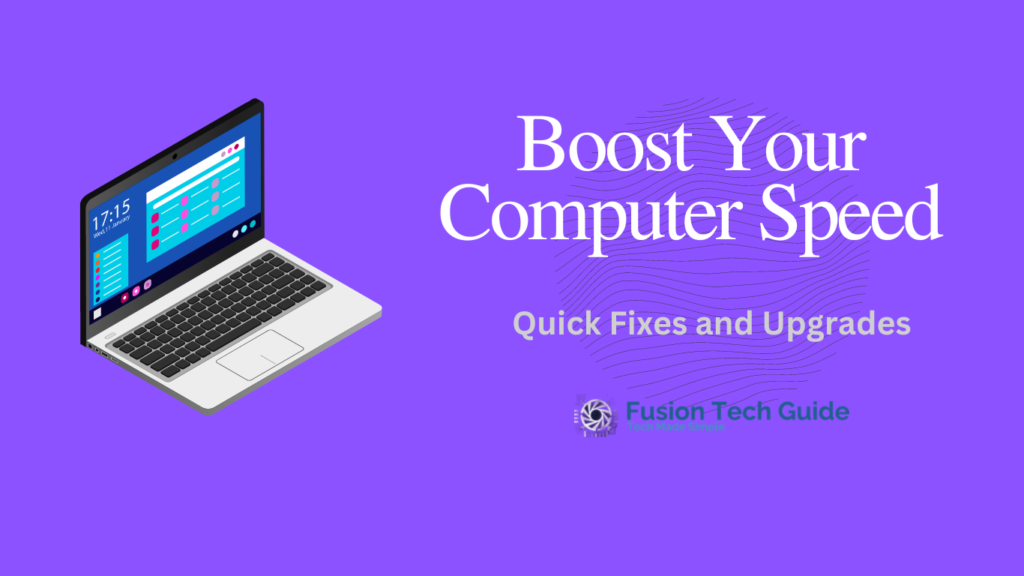Dealing with a slow computer can be a real headache, especially when you have tight deadlines or important projects to tackle. The good news is, there are plenty of ways to get your PC running smoothly again. In this guide, we’ll explore a variety of simple solutions and effective upgrades to help speed up your computer. From cleaning up unnecessary files and programs to optimizing your system settings, we’ll cover practical steps you can take to enhance performance. We’ll also dive into more advanced options, like upgrading your hardware, to give your PC the boost it needs. By following these tips, you can get your computer back on track and working efficiently, so you can focus on what matters most
1. Scan for Malware and Viruses
Malware and viruses are often the culprits behind a sluggish computer. These malicious programs can hijack system resources, leading to noticeable slowdowns.
- Run a Full System Scan: Utilize reputable antivirus software to perform a thorough scan of your system. Programs like Norton, Bitdefender, and Kaspersky can detect and remove harmful software that may be affecting your computer’s speed.
- Use Anti-Malware Tools: In addition to traditional antivirus programs, consider using anti-malware tools such as Malwarebytes. These tools can target and eliminate adware, spyware, and other types of malicious software that might not be detected by conventional antivirus software.
Pro Tip: Regularly update your antivirus and anti-malware tools to ensure they can detect the latest threats.
2. Clean Up Your Hard Drive
An overstuffed hard drive can significantly impact your computer’s performance. Regular maintenance can help keep your hard drive in optimal condition.
- Delete Temporary Files: Temporary files, system cache, and other junk can accumulate over time. Use the built-in Disk Cleanup tool on Windows to remove these files. On macOS, you can use tools like CleanMyMac or manually clear cache files.
- Uninstall Unnecessary Programs: Review your list of installed programs and remove any that are no longer needed. Go to
Control Panel>Programs>Programs and Featureson Windows orApplicationson macOS to uninstall software.
Pro Tip: Use a disk cleanup tool like CCleaner to automate the process of cleaning up temporary files and system cache.
3. Optimize Startup Programs
Programs that start automatically with your computer can slow down boot times and consume resources.
- Manage Startup Programs: On Windows, open Task Manager by pressing Ctrl+Shift+Esc, then navigate to the
Startuptab. Disable programs that are not essential to your workflow. On macOS, go toSystem Preferences>Users & Groups>Login Itemsand remove unnecessary startup items. - Check for Bloatware: Many new computers come with pre-installed software, often called bloatware, that can slow down performance. Use the same method to remove or disable these programs if they are not needed.
Pro Tip: Regularly review and update your startup settings, especially after installing new software.
4. Upgrade Your Hardware
Sometimes, a hardware upgrade is the most effective way to enhance your computer’s performance, particularly if it’s several years old.
- Add More RAM: Increasing the amount of RAM (Random Access Memory) can provide a significant boost in performance, especially for multitasking and running demanding applications. Check your computer’s specifications to find compatible RAM modules and install them according to the manufacturer’s instructions.
- Upgrade to an SSD: Replacing a traditional hard drive with a Solid State Drive (SSD) can dramatically improve boot times and overall system responsiveness. SSDs are faster and more reliable than HDDs, and many modern computers support this upgrade.
Pro Tip: If you’re using a laptop, check if your model supports RAM and SSD upgrades, as some ultrabooks and compact designs might have soldered components.
5. Update Your Software
Keeping your operating system and software up-to-date is crucial for maintaining system performance and security.
- Update Your Operating System: Ensure you have the latest updates and patches installed for your operating system. On Windows, go to
Settings>Update & Security>Windows Update. On macOS, go toSystem Preferences>Software Update. - Update Drivers: Outdated drivers can cause performance issues and conflicts. Visit the manufacturer’s website for your computer’s hardware components (such as graphics cards and network adapters) to download and install the latest drivers.
Pro Tip: Enable automatic updates for both your operating system and software applications to ensure you always have the latest improvements and security fixes.
6. Adjust Visual Effects
Modern operating systems come with various visual effects that, while attractive, can consume system resources and slow down performance.
- Reduce Animations: On Windows, adjust visual effects by going to
System Properties>Advanced>Performance Settings. SelectAdjust for best performanceor manually disable specific effects. On macOS, go toSystem Preferences>Accessibility>Displayand checkReduce motion. - Lower Screen Resolution: Reducing your screen resolution can lessen the load on your graphics hardware, especially if you are using an older computer with less powerful graphics capabilities
Pro Tip: Consider using a simpler desktop background and disabling transparency effects to free up system resources.
7. Check for System Errors
System errors and file corruption can hinder performance. Running system checks can help identify and repair these issues.
- Run System File Checker: On Windows, use the System File Checker tool to scan and repair corrupted system files. Open Command Prompt as an administrator and type the command
sfc /scannow. Follow the on-screen instructions to complete the process. - Run Disk Utility: On macOS, use Disk Utility to check and repair disk errors. Open Disk Utility from the
Utilitiesfolder and selectFirst Aidto run a disk check and repair any issues.
Pro Tip: Regularly schedule disk checks and system scans to maintain optimal system health.
8. Manage Your Browser
A slow or bloated browser can contribute to overall system slowdowns. Managing browser settings and extensions can improve performance.
- Clear Browser Cache: Regularly clear your browser’s cache, cookies, and history to enhance speed and responsiveness. Most browsers have this option in their settings menu.
- Manage Extensions: Disable or remove unnecessary browser extensions that may be consuming resources or causing conflicts. On Chrome, go to
Settings>Extensions, and on Firefox, go toAdd-ons>Extensions.
Pro Tip: Use browser-specific tools or add-ons to help manage and optimize your browsing experience.
9. Reinstall the Operating System
If all else fails and your computer remains slow, consider reinstalling the operating system. This can resolve software-related issues and give your system a fresh start.
- Back-Up Your Data: Before reinstalling, ensure you back up all important data to an external drive or cloud storage service.
- Perform a Clean Install: Follow the instructions for performing a clean installation of your operating system. This usually involves creating installation media (USB or DVD) and booting from it to reinstall the OS.
Pro Tip: After a clean install, reconfigure your system settings and reinstall only the essential applications to avoid clutter.
10. Seek Professional Help
If your computer is still slow after trying the above methods, it might be time to seek professional help. A technician can diagnose hardware issues or perform advanced optimizations.
- Visit a Local Repair Shop: Bring your computer to a local repair shop for a thorough inspection and potential hardware upgrades.
- Contact Manufacturer Support: Reach out to your computer’s manufacturer for assistance and warranty options. They may provide additional troubleshooting steps or repair services.
Pro Tip: Keep your warranty and service agreements handy, as they may cover repairs or parts replacements.
Frequently Asked Questions (FAQ)
What are the common causes of a slow computer?
- Common causes include malware infections, insufficient RAM, a full hard drive, outdated software, and too many startup programs.
How can I tell if my computer needs more RAM?
- If you notice frequent slowdowns while multitasking or running memory-intensive applications, it might be time to add more RAM. You can also check your system’s performance monitor for RAM usage statistics.
Is upgrading to an SSD worth it?
- Yes, upgrading to an SSD can provide a significant boost in performance, including faster boot times and quicker file access. SSDs are more reliable and faster compared to traditional hard drives.
How often should I update my software and drivers?
- It’s a good practice to regularly check for updates for your operating system and drivers. Enable automatic updates where possible to ensure you receive the latest security patches and performance improvements.
What should I do if my computer is still slow after trying these fixes?
- If your computer remains slow despite trying these fixes, consider seeking professional help. A technician can diagnose deeper hardware issues or perform advanced optimizations that might be necessary.



